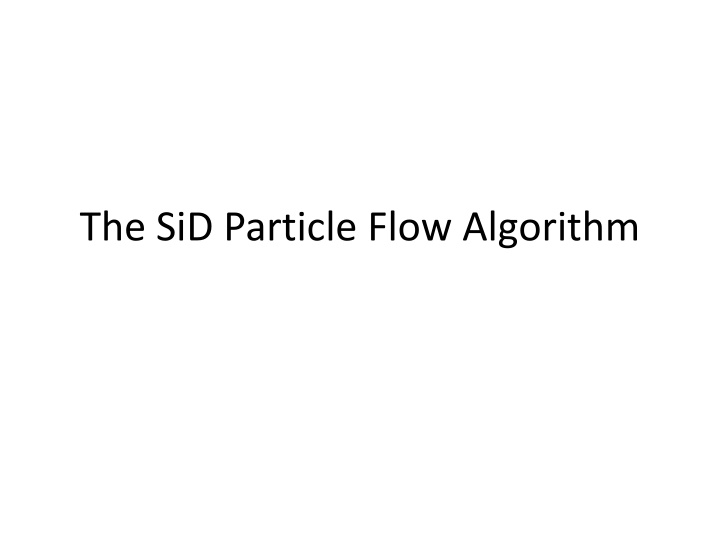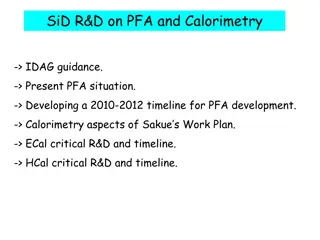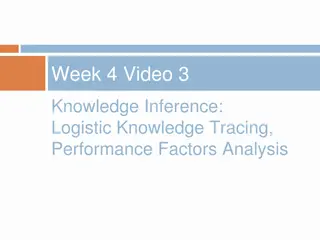
Advanced Particle Flow Algorithm in SiD02: Insights & Future Directions
Explore the intricate workings of the SiD Particle Flow Algorithm with a focus on the SiD02 detector, basic building blocks of the PFA, cluster building techniques, and classification methodologies. Discover the nuances of directed tree clustering, track extrapolation, seed identification, and sub-cluster connectivity, all vital components in reconstructing particles accurately. Uncover the status of the algorithm, recent improvements, and the roadmap for future enhancements in particle flow analysis.
Download Presentation

Please find below an Image/Link to download the presentation.
The content on the website is provided AS IS for your information and personal use only. It may not be sold, licensed, or shared on other websites without obtaining consent from the author. If you encounter any issues during the download, it is possible that the publisher has removed the file from their server.
You are allowed to download the files provided on this website for personal or commercial use, subject to the condition that they are used lawfully. All files are the property of their respective owners.
The content on the website is provided AS IS for your information and personal use only. It may not be sold, licensed, or shared on other websites without obtaining consent from the author.
E N D
Presentation Transcript
List of Contents Assume Particle Flow needs no introduction The SiD02 used in the PFA An Overview of the algorithm Status at the time of LOI Introspection of the SiD-PFA The fix-ups and improvements Where we are Where to next (short and longer term)
The Detector (SiD02) ECAL: 30+1 layers of (320 m Si + 2.5/5.0mm W), 3.5 x 3.5mm cells. HCAL: 40 layers of (1.2mm RPC + 2cm steel), 1cm x 1cm cells. 3
Basic Building Blocks of the (Iowa) PFA MC hits within 100 ns from IP are digitized Photon, Muon and Electron ID Track and Seed Cluster (Directed Tree) Building Charged Hadron Shower Reconstructing Particles (four-vectors) Photon, Muon and Electron ID Initial EM Cluster Starts early in ECAL with a tight core and longitudinal profile No track matched photon Track matched with E/p 1 , electron Special case: Possibility of overlap with other showers Muon Find MIP direction in Muon detector, match extrapolated track Of course, charged hadrons behave similar to a MIP before showering Special case: Overlaps with EM and hadron showers These hits are removed from the hit list for clustering algorithm 4
Categorizing: DirectedTree Clustering Use DirectedTree Cluster for classification into sub-cluster types using the remaining hits 5
Cluster Building Extrapolate (each) track to the ECAL surface Find Seed: sub-cluster directly connected to extrapolated track Each track typically has one seed Special cases: track without seed, or does not reach calorimeter Now start connecting other sub-clusters to the seed of each track Start with lowest and then progressively higher momentum tracks Connecting Clusters Scoring :(a poor man s) Probability of a link Based on the sub-cluster type and geometric proximity a score between 0 and 1 is assigned between any two sub-clusters starting with the cluster in consideration The higher the score the higher the probability of a link A cut-off threshold is obtained at an energy by tuning with events 6
Energy dependence Performance at LOI Study just how much is contributed because of leakage 8
Leakage study at 500 GeV and 1 TeV Produce data sets a SiD02-like detector MC with 6 HCAL for 1 TeV, 500 GeV, 200 GeV Change Steel for Cu for absorber Increase to 54 layers from 40 layers in HCAL 1.7 more material in HCAL No gap between HCAL and Muon endcap (instead of 10 cm) Compare sid02 with sid02-Cu at various energies Check leakage by observing # hits in Muon detector : punch thru; a measure of leakage Simultaneouslystudy the corresponding change in Energy resolution The relative measure from the two gives an approximate semi-quantitative measure of leakage vs performance Although substantial leakage is present at 500 GeV confusion is clearly important 9
Punch-through muon hits SiD02-Cu SiD02 10
Resolution study (SiD02-Cu comparison) real tracking SiD02-Cu SiD02 11
Conclusions from Leakage study At 1 TeV leakage comparison shows large difference in performance between SiD-nominal (dashed) and SiD-Cu detectors (solid) At 500 GeV leakage comparison shows significant difference in performance between SiD-nominal (dashed) and SiD-Cu detectors (solid) Performance of 1 TeV SiD-Cu is similar to 500 GeV SiD-nominal in leakage At 1 TeV performance in resolution is worse with SiD-nominal (dashed) and SiD-Cu detectors (solid) At 500 GeV performance in resolution is worse with SiD-nominal (dashed) and SiD-Cu detectors (solid) However : The difference of performance in resolution between 1 TeV SiD-Cu and 500 GeV SiD-nominal is not similar to that in leakage Although substantial leakage is present at 500 GeV, algorithm (confusion) plays an important part 12
Anatomy of the Algorithm Cone : Originally installed to pick up secondary neutrals immediately before the LOI submission A part used early in the clustering found to be very aggressive An example in next slide This early part is now disabled Sharing of hits: Associating clusters to tracks with increasing momenta Hits associated with one track are not allowed to be associated with other tracks Started study of sharing hits; test purity & efficiency Note: Many isolated hits left are later used and shared among nearby tracks
has a low energy 12 GeV neutral hadron and several photons present in the ECAL; interaction of charged hadron p (orange) = 119 GeV, E/p match, enough hits (green) = 17 GeV reconstructed RefinedCheatCluster Diagnosis of `A problem: an example RefinedCluster - sharedhits Had introduced a cone-like path in the reclustering to pick up secondary neutrals; but ends up being too aggressive 14
Next Steps Allow flexibility in assignment of hits in clusters from tracks in the vicinity, allocate after arbitration Break up into smaller clusters for assigning and matching Extend links to disjointed pieces of clusters cleverly Faster turn around time A challenging major step : Incorporate the PFA with SiD03 geometry Expect to take a step backward: non-trivial Employ sophisticated modifications for special types of clusters, like backscattering, complex rare occurrences Finally : test resolution with radiation turned on






















